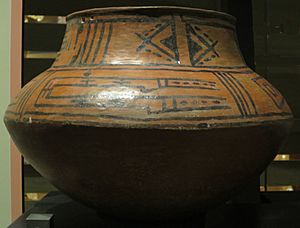Puye Cliff Dwellings facts for kids
|
Puye Ruins
|
|

Entrances to the dwellings
|
|
| Lua error in Module:Location_map at line 420: attempt to index field 'wikibase' (a nil value). | |
| Nearest city | Española, New Mexico |
|---|---|
| Area | 1,350 acres (550 ha) |
| Built | 1250 |
| NRHP reference No. | 66000481 |
Quick facts for kids Significant dates |
|
| Added to NRHP | October 15, 1966 |
| Designated NHL | May 23, 1966 |
The Puye Cliff Dwellings are the remains of an old village built by the Puebloan peoples. You can find them in Santa Clara Canyon on land belonging to the Santa Clara Pueblo, near Española, New Mexico. This special place was named a National Historic Landmark in 1966, meaning it's very important to the history of the United States.
Contents
Life in the Ancient Puye Village
Between the years 900 and 1580, up to 1500 Pueblo people lived in this area. They hunted animals and grew their own food. The first people settled here in the late 900s, living in small farmhouses on the east side of the Jemez Mountains. Over time, their villages grew larger and more focused. They built bigger communities like Otowi, Puye, Shufinne, Tsankawi, Tsirege, and Tyuonyi.
Exploring the Puye Cliffs Complex
The Puye Cliffs complex is the biggest of its kind on the Pajarito Plateau. It has two levels of homes built into the cliffs, plus houses on the flat mesa top and in caves. You can reach the cliff homes and a rebuilt 'Community House' by walking on paths and using about twelve stairways and ladders cut right into the cliff. One level of cliff homes stretches for over 1 mile (1.6 km), and the other is about 2,100 feet (640 m) long.
The homes were carved out of a soft rock called volcanic tuff. This rock is about 200 feet (61 m) high. Because the rock is soft, the ancient people could dig out their homes using simple wooden tools. The cliff dwellings had about 740 rooms. There were also ruins at the bottom of the cliff, which likely held even more homes.
On top of the mesa, there were cave dwellings from earlier times. Around these caves, a large village with many stories was built. The southern part of this village had 173 rooms on the ground floor alone. We don't know the total number of rooms, as there were more on the northern side and on upper levels. In the middle of the village was a big open area, like a town square.
Why Puye Was Left Behind
Around the year 1580, a long period of dry weather, called a drought, forced the villagers to leave. They moved to places closer to the Rio Grande river valley, where water was easier to find. The people living in the Santa Clara Pueblo today, about 10 miles (16 km) to the east, are related to the ancient Puye villagers.
The Native American people who live in pueblos in northern New Mexico usually speak the Tewa language. In Tewa, the name 'Puye' means 'pueblo ruin where the rabbits gather or meet'.
Discovering the Ruins
In 1907, a person named Edgar Hewett led a team from the Archaeological Institute of America. They started digging at Puye Cliffs. This was the first time anyone had carefully studied and dug up an ancient pueblo in the Rio Grande valley.
Puye's Recent History

The Puye Cliff Dwellings were officially named a National Historic Landmark in 1966. This was done to protect and recognize their importance.
A special quote about the site says:
Established in the late 1200s or early 1300s and abandoned by about 1600, this is among the largest of the prehistoric Indian settlements on the Pajarito Plateau, showing a variety of architectural forms and building techniques. It is located on the Santa Clara Indian Reservation.
The Cerro Grande Fire
In 2000, a planned fire to clear trees in Bandelier National Monument got out of control. This huge wildfire, called the Cerro Grande Fire, burned over 46,925 acres (189.90 km2) of land. It also destroyed about 250 homes in Los Alamos and caused a lot of damage in Santa Clara Canyon.
Luckily, the Puye Cliff Dwellings site was able to reopen to visitors in 2009. If you want to visit, you can get the latest information from the Santa Clara Pueblo. You can even schedule tours to explore the cliffs and learn more about their amazing history.
Puye in Movies
The Puye area was shown a lot in the 1952 movie "The Atomic City".
Images for kids
-
A Kiva (a special room for ceremonies) and other ruins on top of the mesa.
-
Ancient carvings on rocks, called Petroglyphs.





